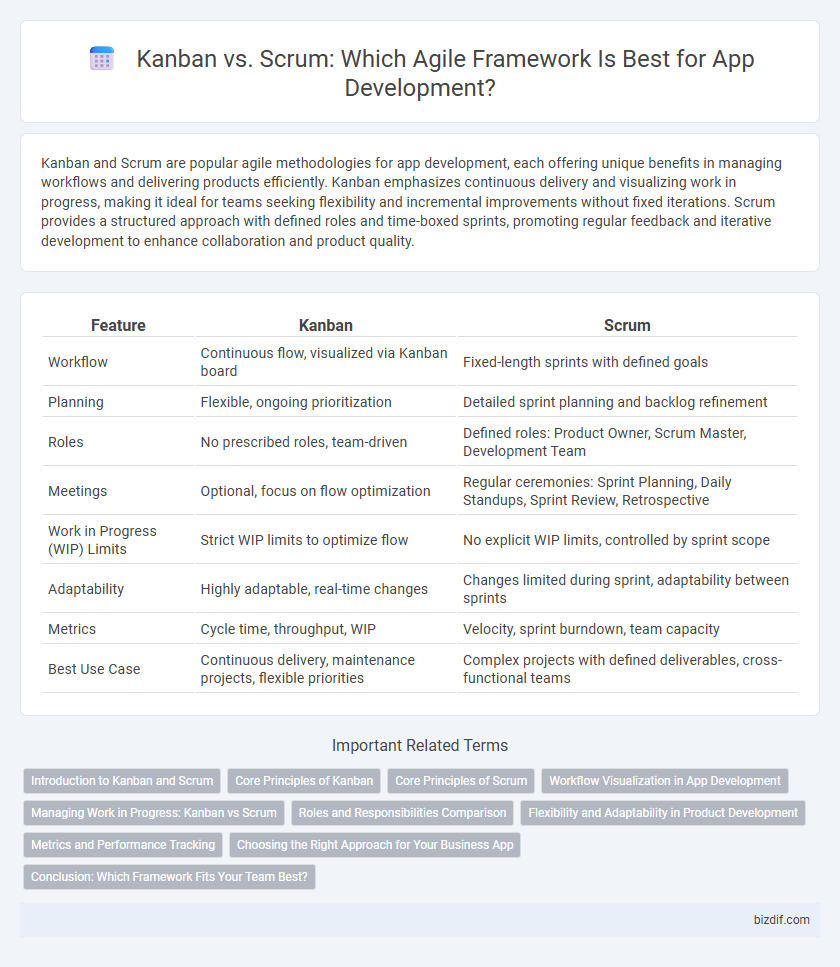Kanban and Scrum are popular agile methodologies for app development, each offering unique benefits in managing workflows and delivering products efficiently. Kanban emphasizes continuous delivery and visualizing work in progress, making it ideal for teams seeking flexibility and incremental improvements without fixed iterations. Scrum provides a structured approach with defined roles and time-boxed sprints, promoting regular feedback and iterative development to enhance collaboration and product quality.
Table of Comparison
| Feature | Kanban | Scrum |
|---|---|---|
| Workflow | Continuous flow, visualized via Kanban board | Fixed-length sprints with defined goals |
| Planning | Flexible, ongoing prioritization | Detailed sprint planning and backlog refinement |
| Roles | No prescribed roles, team-driven | Defined roles: Product Owner, Scrum Master, Development Team |
| Meetings | Optional, focus on flow optimization | Regular ceremonies: Sprint Planning, Daily Standups, Sprint Review, Retrospective |
| Work in Progress (WIP) Limits | Strict WIP limits to optimize flow | No explicit WIP limits, controlled by sprint scope |
| Adaptability | Highly adaptable, real-time changes | Changes limited during sprint, adaptability between sprints |
| Metrics | Cycle time, throughput, WIP | Velocity, sprint burndown, team capacity |
| Best Use Case | Continuous delivery, maintenance projects, flexible priorities | Complex projects with defined deliverables, cross-functional teams |
Introduction to Kanban and Scrum
Kanban is a visual project management method that emphasizes continuous delivery and workflow visualization using boards and cards to track tasks. Scrum is an agile framework that organizes work into fixed-length sprints, promoting collaboration through defined roles like Scrum Master and Product Owner. Both approaches enhance software development efficiency but differ in structure, with Kanban offering flexibility and Scrum providing iterative progress cycles.
Core Principles of Kanban
Kanban centers on visualizing work, limiting work in progress, and managing flow to enhance efficiency and flexibility in app development. Its core principles include visual workflow management through Kanban boards, continuous delivery without fixed iterations, and promoting collaboration by making bottlenecks visible. This approach allows development teams to adapt quickly and optimize productivity by focusing on completing tasks before starting new ones.
Core Principles of Scrum
Scrum revolves around iterative development, empirical process control, and cross-functional teamwork to deliver high-quality software efficiently. Its core principles include transparency, inspection, and adaptation, ensuring continuous improvement and responsiveness to change throughout the project lifecycle. Scrum emphasizes defined roles such as Product Owner, Scrum Master, and Development Team to facilitate collaboration and accountability.
Workflow Visualization in App Development
Kanban and Scrum both enhance workflow visualization in app development by providing clear, real-time views of task progress and bottlenecks. Kanban uses a continuous flow board with columns representing stages such as backlog, development, testing, and deployment, allowing teams to manage workload dynamically and limit work in progress. Scrum employs sprint-based boards, highlighting prioritized user stories, tasks, and daily progress within time-boxed iterations to facilitate focused delivery and iterative improvement.
Managing Work in Progress: Kanban vs Scrum
Kanban optimizes work in progress (WIP) by limiting tasks through visual boards, enabling continuous flow and reducing bottlenecks effectively. Scrum manages WIP by dividing work into fixed-length sprints, emphasizing time-boxed commitment and iterative delivery. Teams using Kanban achieve flexibility in task prioritization, while Scrum teams benefit from structured planning and regular review cycles.
Roles and Responsibilities Comparison
Kanban roles focus on continuous delivery with team members managing workflow without defined roles, emphasizing flexibility and self-organization. Scrum defines specific roles including Product Owner, Scrum Master, and Development Team, each with distinct responsibilities like backlog management, process facilitation, and sprint execution. Scrum roles enforce structured collaboration, while Kanban promotes adaptive task management within cross-functional teams.
Flexibility and Adaptability in Product Development
Kanban offers continuous workflow flexibility by allowing teams to manage tasks without fixed iterations, adapting quickly to changing priorities in product development. Scrum emphasizes adaptability through time-boxed sprints and regular retrospectives, promoting iterative progress and quick response to feedback. Both methodologies enhance product development agility, but Kanban's flow-based approach provides more real-time adaptability compared to Scrum's structured sprint cycles.
Metrics and Performance Tracking
Kanban emphasizes continuous flow metrics such as cycle time and work-in-progress limits to enhance efficiency, while Scrum relies on velocity and sprint burndown charts to measure team performance over fixed iterations. Kanban's real-time tracking enables immediate identification of bottlenecks, fostering incremental improvements. Scrum's structured metrics support predictable delivery schedules and facilitate performance reviews at sprint retrospectives.
Choosing the Right Approach for Your Business App
Kanban offers continuous delivery and flexibility, ideal for projects requiring ongoing updates and prioritization, while Scrum provides structured sprints and defined roles, suited for teams needing clear deadlines and iterative progress. Evaluating your business app's complexity, team experience, and customer feedback frequency helps determine the best methodology. Integrating tools like Jira or Trello can enhance tracking and collaboration, ensuring alignment with your development goals.
Conclusion: Which Framework Fits Your Team Best?
Choosing between Kanban and Scrum depends on your team's workflow needs and project complexity; Kanban suits continuous delivery and flexible task management, while Scrum excels in structured, iterative development with fixed sprints. Teams prioritizing adaptability and real-time process visualization benefit from Kanban's pull-based system, whereas those requiring regular feedback cycles and defined roles thrive with Scrum's time-boxed approach. Evaluate your project demands, team size, and collaboration style to select the framework that maximizes productivity and aligns with your development goals.
Kanban vs Scrum Infographic

 bizdif.com
bizdif.com